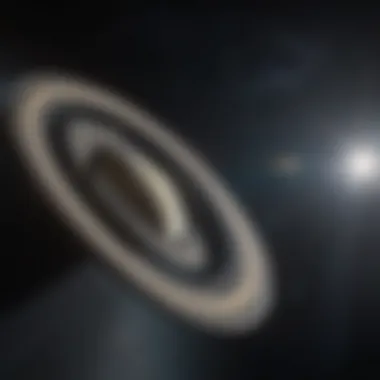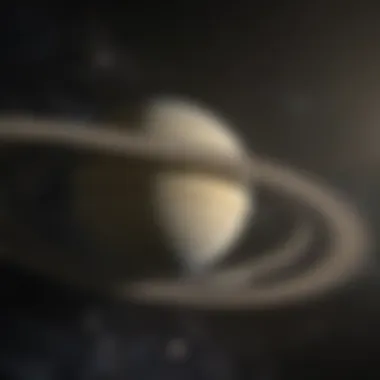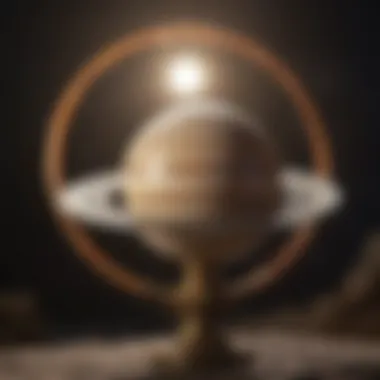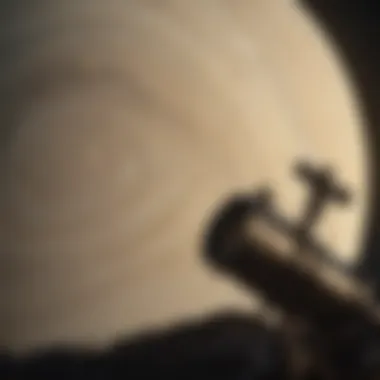Locating Saturn: A Comprehensive Guide to Its Significance


Intro
Saturn holds a unique position in our solar system, both in its physical attributes and its astrological significance. Known for its prominent rings and multiple moons, this planet has captivated many for centuries. The approach to locating Saturn and understanding its influence in astrology can equip enthusiasts with valuable insights into their personal lives and broader cosmic patterns. This article will guide you through the steps to locate Saturn, analyze its astrological profiles, and explore its profound impact on relationships and individual horoscopes.
Zodiac Profiles
Overview of Each Sign
Saturn plays a crucial role in the astrological profiles of individuals. Each sign holds distinct traits shaped by Saturn's influence. Here is a brief overview of the signs:
- Aries: Adventurous, yet may struggle with impulsivity.
- Taurus: Reliable and practical, but can be stubborn.
- Gemini: Adaptable and curious, but may lack focus.
- Cancer: Nurturing and intuitive, yet can be overly sensitive.
- Leo: Creative and confident, but may crave attention.
- Virgo: Analytical and detail-oriented, though can be overly critical.
- Libra: Diplomatic and charming, but may avoid conflict.
- Scorpio: Passionate and resourceful, but can be secretive.
- Sagittarius: Optimistic and adventurous, yet restless.
- Capricorn: Disciplined and ambitious, though may be overly serious.
- Aquarius: Innovative and independent, but can be aloof.
- Pisces: Compassionate and artistic, yet may struggle with reality.
Personality Traits
The interaction of Saturn with each zodiac sign yields unique personality traits. It fosters resilience, discipline, and a sense of responsibility, which can either enhance or hinder individual growth. Saturn encourages each sign to confront challenges and face their fears.
Strengths and Weaknesses
Understanding strengths and weaknesses is essential for self-growth. Some signs thrive under Saturn's influence and exhibit determination. Others may grapple with feelings of insecurity or self-doubt. Knowing these dynamics helps individuals navigate personal dilemmas and cosmic energies effectively.
Compatibility Insights
Love and Relationships
Saturn's placement in a natal chart can significantly influence romantic dynamics. The planet encourages commitment and loyalty, often leading to long-lasting relationships. Understanding how Saturn interacts with different signs allows individuals to recognize potential challenges and harmonies in their partnerships.
Friendship Compatibility
Friendships also reflect Saturn's role. Bonds forged under Saturn may be profound and reliable. Some signs resonate better with Saturn's energy, encouraging mutual respect and loyalty, while others may encounter misunderstandings or conflicts in their friendships.
Workplace Dynamics
Saturn's influence extends to career and workplace relationships. Those with robust Saturn placements may excel in structured environments that demand discipline and responsibility. Conversely, some signs may find themselves in friction with Saturn's authoritative energy, particularly in hierarchical settings.
Astrological Events
Monthly/Weekly Horoscope Breakdown
Tracking the positioning of Saturn in the sky gives valuable insights into current astrological events. Regularly reviewing horoscopes allows individuals to align their actions with cosmic trends.
Notable Celestial Events
Significant celestial events, such as Saturn retrograde, provide unique opportunities for reflection and growth. Understanding these events can aid in personal decision-making and enhance life experiences.
How to Prepare for Astrological Shifts
Preparation for astrological shifts requires awareness and adaptability. Observing Saturn's phases and transitions can benefit personal development. Gradual alignment with these shifts allows individuals to harness the potential energies of each phase.
Understanding Saturn's Position
Understanding the position of Saturn within the solar system is crucial for both astronomical and astrological perspectives. For astronomers, it provides insights into the dynamics of the solar system and helps in predicting the movements of celestial bodies. For astrology enthusiasts, the knowledge of Saturn's position allows for a deeper comprehension of its impact on personal horoscopes and life experiences. By exploring Saturn's orbit, distance from the Sun, and visibility, one can appreciate its significance in the celestial landscape and its effects on human affairs.
The Solar System Overview
The solar system consists of the Sun and all the celestial objects that are bound to it by gravity. This includes the eight major planets, including Saturn, along with their moons, dwarf planets, and numerous asteroids and comets. Saturn is the sixth planet from the Sun and is well known for its extensive ring system, positioning it as one of the most fascinating objects of study.
Saturn is categorized as a gas giant, which means it primarily consists of hydrogen and helium. Its unique features, such as the rings and its numerous moons, contribute to its importance within the solar system. Understanding Saturn's overview helps to contextualize its role in astrophysical studies as well as its astrological interpretations.
Saturn's Orbit and Distance
Saturn's Average Distance from the Sun
Saturn's average distance from the Sun is about 1.43 billion kilometers or 886 million miles. This substantial distance affects many aspects of the planet, including its orbital period, which is approximately 29.5 Earth years. Such distance brings Saturn into a unique position among the planets, making it a significant target for both observation and study.
The vast distance contributes to the planet's gas giant classification, as it possesses a gaseous environment that is vastly different from terrestrial planets like Earth. Additionally, this distance influences visibility from Earth and can create challenges for astronomers seeking to study Saturn closely through telescopic observations.
Comparison with Other Planets
When compared to other planets, Saturn's distance from the Sun places it further out in the solar system. For example, Jupiter, the largest planet, orbits at a distance of approximately 778 million kilometers or 484 million miles—much closer than Saturn. This distance means that Saturn has a longer orbital period and experiences different seasonal cycles than its closer counterparts. Understanding this comparison enhances awareness of the solar system's structure and the relative positions of each planet.


Saturn's position also means it has a specific alignment with the Zodiac, influencing astrological readings and interpretations. This positioning provides context for why Saturn is often associated with lessons on discipline, responsibility, and structure in personal horoscopes.
Visibility from Earth
Optimal Viewing Conditions
To observe Saturn successfully, optimal viewing conditions are essential. This includes clear skies, minimal light pollution, and the right time of year when Saturn is at opposition in its orbit. Under such conditions, Saturn can shine brightly and be easily observed with the naked eye or through telescopes.
These conditions enhance the experience of watching Saturn, allowing observers to appreciate its unique ring structure. Observing Saturn during these times not only provides a visual treat but also allows for scientific data collection that enhances our understanding of the planet.
Seasonal Variations
The visibility of Saturn can vary with the seasons. As the Earth moves around the Sun, the position of Saturn shifts in the night sky. Different times of the year will present Saturn in varying degrees of brightness and elevation. Knowing these seasonal variations allows observers to better plan viewing efforts and appreciate the changes in Saturn's position.
For instance, during the late summer and fall months in the northern hemisphere, Saturn tends to be more prominent and easier to spot in the evening sky. This consideration enhances the practical aspect of stargazing and urges enthusiasts to engage with Saturn's movements throughout the year, fostering a deeper connection with celestial mechanics.
Saturn's Physical Characteristics
Saturn's physical characteristics are crucial for understanding its role in our solar system and its significance in astrological practice. The planet's unique features, such as its gaseous environment and intricate ring system, provide insights into its composition and behavior. This section aims to explore these aspects in depth, demonstrating how Saturn's properties influence both scientific observation and astrological interpretation.
Composition and Structure
Gaseous Environment
Saturn is primarily a gaseous planet, which makes its environment remarkably distinct. The planet lacks a solid surface, instead comprising layers of gases, predominantly hydrogen and helium. This gaseous environment contributes greatly to understanding Saturn's overall structure and dynamics. Key characteristic of Saturn's gaseous atmosphere is its complexity.
The gas giants, including Saturn, present challenges for spacecraft and telescopes as well. The unique feature of Saturn's gaseous environment allows for the study of cloud patterns and storms that can be observed over long periods.
Advantages of studying Saturn's gaseous structure include:
- Understanding planetary formation and evolution.
- Learning about atmospheric dynamics in gas giant planets.
However, there are also disadvantages such as the difficulty in gathering direct data from atmospheric conditions due to turbulent and fluctuating patterns.
Ring System
Saturn's ring system is its most distinguishing feature, making it one of the most iconic planets in our night sky. The rings are composed mainly of ice particles, along with other materials such as dust and rock. This unique feature enhances the study of planetary rings in general, as Saturn's system is the most expansive and complex known.
One key characteristic of the ring system is its segmentation, which includes main rings and gaps. The differentiation of rings provides insights into the processes of celestial mechanics and gravitational interactions. Notably, this makes studying Saturn's rings an engaging choice for those in the field of astro-navigation and astrophysics.
The ring system showcases various advantages:
- It allows for the exploration of the composition and dynamics of ring structures.
- It offers a window into the interactions between moons and rings, deepening our understanding of stellar formations and orbital mechanics.
Nevertheless, the presence of debris within the rings and the ever-changing nature can also complicate direct observation efforts.
Atmospheric Conditions
Temperature Range
The temperature range of Saturn is wide and varies significantly within its atmospheric layers. The outer layers are relatively cold, with temperatures averaging around -178 degrees Celsius. However, deeper layers experience significant heat, stemming from the planet's slow gravitational compression. This variation in temperature plays an important role in atmospheric dynamics and weather phenomena.
A key characteristic of this temperature range is its complexity which affects wind patterns and cloud formation. It allows for a deeper understanding of why Saturn experiences extreme weather events.
Studying Saturn's temperature range provides benefits such as:
- Insight into the thermal equilibrium of gas giants.
- Understanding seasonal changes at different latitudes.
On the flip side, understanding temperature fluctuations can be a disadvantage as they add complexity to modeling atmospheric conditions.
Wind Speeds
Saturn's wind speeds are among the fastest in the solar system. They can exceed 1,800 kilometers per hour in the planet’s upper atmosphere. Such extraordinary wind speeds are crucial for understanding the planet's meteorology and cloud movement.
A notable characteristic of these wind speeds is the presence of jet streams, which exhibit distinct patterns and can lead to fascinating weather phenomena like storms. For those interested in planetary science, wind speeds are an engaging area of study to explore atmospheric circulation.
The advantages of studying wind speeds include:
- Improved models of atmospheric dynamics and energy distribution.
- Interaction effects between wind and the planet's rotation.
However, the high-speed winds also present challenges, as they can complicate observations and make data collection more difficult.


Understanding Saturn’s atmospheric characteristics is essential for a comprehensive view of planetary systems and their behaviors as well as for astrological interpretations.
Historical Observations of Saturn
The historical observations of Saturn provide an essential foundation for our understanding of the planet and its place within astronomy and astrology. Tracking Saturn through the ages has allowed astronomers and astrologers alike to develop a deeper connection to this distant gas giant. It has shaped perspectives on planetary motion and contributed significantly to advancing our knowledge of celestial mechanics.
Early Astronomical Discoveries
Saturn has fascinated humans for thousands of years. Ancient civilizations, such as the Babylonian astronomers, were among the first to document Saturn. They used simple tools, like the naked eye, to observe its unique rings and noticeable brightness. The Greeks later identified Saturn as the farthest planet visible without a telescope.
The invention of the telescope marked a turning point in the study of Saturn. In 1610, Galileo Galilei became the first astronomer to view Saturn through a telescope. His observations revealed the planet's rings, although he misinterpreted them as
Astrological Significance of Saturn
The astrological significance of Saturn is multi-faceted and profound, making it a crucial area of study for enthusiasts of astrology. This segment outlines the importance of Saturn within the astrological framework. Saturn embodies lessons of discipline, responsibility, and the trials one faces in life, which makes its influence significant in horoscopes.
Saturn in Astrology
Symbolism and Influence
Saturn symbolizes structure, limitation, and boundaries. Its influence on individuals can often be seen in their approach to challenges and responsibilities. Saturn’s key characteristic is its role as a teacher, presenting life lessons that help in personal growth. This makes it a beneficial choice for those seeking deeper understanding of their life path.
The unique feature of Saturn's symbolism lies in its dual nature; it can be both a restrictive and a protective force. While limitations can appear burdensome, they often lead to significant personal development. Understanding this can provide advantages in making informed decisions in life.
Saturn's Role in Zodiac Signs
In astrology, Saturn's role varies among the different zodiac signs, adding an additional layer to its significance. For example, in Capricorn, Saturn is at home, emphasizing ambition, practicality, and diligence. This indicates that Saturn exerts strong influence in helping individuals attain their goals.
Saturn's unique feature here is that its placement determines how its lessons manifest in an individual’s life. Each sign brings forward distinct challenges that must be faced. This variability can make it a popular topic among those trying to understand their astrological influences.
Saturn's Return
Definition and Importance
Saturn's Return occurs approximately every 29.5 years and represents a period of maturation and self-reflection. This phase is often marked by significant life changes and transitions, making it an important milestone for individuals. The key characteristic of Saturn’s Return is that it teaches responsibility and encourages reassessment of life goals.
The unique feature of this event lies in its timing; it can serve as a wake-up call to those who have strayed from their intended life paths. Understanding it provides valuable insight into personal growth and purpose.
Impact on Personal Development
The impact of Saturn's Return on personal development is profound. It often marks a time for individuals to confront their fears, re-evaluate their choices, and make necessary life adjustments. The key characteristic here is the culmination of prior experiences into actionable wisdom, guiding them toward a more meaningful life.
The unique feature of this phase is its emphasis on accountability, pushing individuals to take ownership of their actions. This naturally leads to personal advancement but can also result in resistance for those unprepared for such introspection. Thus, it is essential for anyone experiencing this cycle to be open to change and growth.
Practical Observational Techniques
Observing Saturn is a task that requires attention and appropriate methods. Practical observational techniques are essential in helping enthusiasts effectively locate and study this majestic planet. They equip observers with the understanding needed to maximize their viewing experiences.
Using Telescopes
Types of Telescopes Suitable for Viewing Saturn
When it comes to observing Saturn, certain types of telescopes stand out. Refractor telescopes, with their lenses, offer high-quality images. They provide sharp and clear views of Saturn's rings and atmospheric details. Reflector telescopes, utilizing mirrors, are also popular. They generally offer larger apertures for observing faint details in the planet's environment.
Both types have their merits. The refractor is known for its clarity, while the reflector is favored for its light-gathering capacity. When choosing a telescope, consider its aperture size. A larger aperture allows for better resolution and detail. Thus, a telescope with an aperture of at least 4 inches is recommended for observing Saturn effectively.
Best Practices for Observation
Once you have selected a telescope, implementing best practices is vital. One important aspect is the time of observation. Observing Saturn during its highest point in the night sky enhances visibility. Adjust the focus slowly until you achieve a clear image. This can dramatically improve the viewing experience.
Using a moon filter can also reduce glare and improve contrast. Observers should take time to familiarize themselves with the telescope settings to achieve optimal viewing conditions. Even experienced astronomers benefit from practicing these techniques to enhance their observation effectiveness and satisfaction.
Software and Applications
Stargazing Apps
With advancements in technology, stargazing apps have become indispensable tools for many astronomy enthusiasts. These apps provide real-time data about celestial bodies, including Saturn. They often come equipped with augmented reality features, making it easy for users to identify stars and planets in the night sky.
Stargazing apps like SkySafari or Star Walk are user-friendly options. They simplify the process of locating Saturn and allow for an interactive experience. The ability to have interactive star charts at your fingertips makes these tools beneficial for anyone looking to pinpoint Saturn amidst other celestial bodies.
Simulation of Saturn’s Position


Simulating Saturn's position has practical uses too. Software such as Stellarium allows users to visualize Saturn's location at any given time. These simulations can help in planning future observations. Observers can set specific dates and times to see how Saturn will appear in the night sky.
The advantage of using simulation software is that it enables precise planning. Observers can anticipate when Saturn will be most visible in their region, which aligns well with the goal of effective observation. However, one must also remain aware that simulations may vary from real-time visibility due to atmospheric conditions.
Understanding these tools and methods enriches the experience of observing Saturn, making it more accessible and enjoyable for enthusiasts.
Saturn's Influence in Personal Horoscopes
Saturn's placement in personal horoscopes has significant weight in astrological interpretation. This section elucidates its importance, the specific elements involved, and the benefits of understanding Saturn's influence. Saturn is often seen as a teacher, imposing structure and discipline in individual lives. By studying its position in a natal chart, one can glean insights into their struggles, strengths, and areas for growth.
Interpreting Saturn's Placement
Houses and Their Meaning
The houses in astrology represent different life areas, and Saturn's placement reveals much about an individual's experiences in those aspects. Each house governs specific themes, such as relationships, career, and personal growth.
For example, if Saturn is located in the seventh house, often linked to partnerships, it implies a need for commitment and possibly challenges in relationships. This characteristic makes examining houses essential for a complete understanding of personal horoscopes.
The benefit of knowing Saturn's house placement lies in identifying life lessons tied to Structure and Responsibility. Understanding which house is influenced can empower individuals to navigate challenges effectively. Its unique feature is that each house highlights struggles and lessons specific to one’s life journey. It is a major asset for personal development, although navigating these lessons can sometimes be arduous.
Saturn's Aspects
The aspects of Saturn reveal the relationships it forms with other planets in a horoscope. These connections can highlight tensions or harmonies, dictating how Saturn's energies manifest. Different aspects can indicate challenges or support, significantly influencing one's approach to various life situations.
For example, a trine aspect between Saturn and Venus suggests a supportive relationship with love and commitment, while a square aspect may point to hurdles in connecting with loved ones. This aspect of Saturn is beneficial because it adds layers to understanding personal traits and challenges in relationships and career paths.
Saturn's unique feature is its ability to represent both difficulty and strength, depending on the aspects formed. This duality can allow individuals to embrace their challenges as avenues for growth, though it may sometimes show a tough path ahead.
Saturn in Different Zodiac Signs
Impacts on Personality Traits
Saturn's placement in different zodiac signs shapes various personality traits. For instance, someone with Saturn in Capricorn is likely disciplined and ambitious, while those with Saturn in Gemini may show versatility but struggle with consistency. Understanding these traits is vital for deeper self-awareness.
The characteristic of Saturn in each sign showcases a distinct flavor of learning and experience. This aspect is significant as it nuances the broader understanding of personality. One advantage of analyzing these traits is that it helps individuals align with their natural tendencies and overcome inherent challenges. It offers insights into how one may approach tasks or relationships, though the complexity of these characteristics can sometimes be challenging to navigate.
Relationship Dynamics
The influence of Saturn on relationship dynamics is profound. The sign hosting Saturn can determine how individuals behave in partnerships. For instance, those with Saturn in Libra often perceive relationships through the lens of balance and justice, driving them toward fair partnerships.
This characteristic can be advantageous, offering a framework within which relationships can thrive. The unique feature of Saturn in this context is its contribution to long-term commitment and structure in relationships. Individuals can benefit from recognizing the patterns set by Saturn in their charts; however, this can also lead to rigidity in thinking and difficulty in adapting to change.
Understanding Saturn's role in your personal horoscope unveils life lessons and growth opportunities. Its influence is a blend of discipline, structure, and profound life experiences.
Future Exploration of Saturn
Exploring Saturn is crucial for expanding our understanding of this unique planet. It holds many mysteries and can reveal more about the formation of our solar system. Future exploration will focus on two primary areas: upcoming missions to Saturn and advancements in astronomical technology. These aspects will facilitate our observation and research of Saturn, making it a rich focus for astronomers and enthusiasts alike.
Upcoming Missions
Planned Space Missions to Saturn
Planned space missions to Saturn, such as the Dragonfly mission, are significant exploratory steps. Dragonfly is a rotorcraft lander that will fly to dozens of promising locations on Titan, Saturn's largest moon. Its innovative design can cover large distances. This characteristic makes it a remarkable choice for gaining insights into Titan's complex chemistry and potential for life.
One unique feature of this mission is its mobility. Unlike previous spacecraft, Dragonfly will not be restricted to a single landing site, allowing for diverse surface exploration. This advantage enables scientists to gather data on various environments.
Research Objectives
The research objectives tied to these missions are essential. They aim to investigate Saturn's rings, moons, and atmosphere. Key objectives include understanding the origin of Saturn's rings and studying Titan’s atmosphere and surface. This is important because Saturn's rings hold clues about the planet's history.
A unique characteristic of this research is its broad approach. It includes both physical characteristics and potential astrobiological implications. This dual focus makes it beneficial for comprehending not only Saturn but also broader questions related to planetary formation.
Advancements in Astronomical Technology
New Telescopic Developments
New telescopic developments are enhancing our ability to observe Saturn from Earth. Telescopes like the James Webb Space Telescope offer unprecedented clarity. They can capture detailed images of Saturn and its rings.
This capacity to provide higher resolution is a key development for amateur and professional astronomers. Observing details that were impossible before is now more accessible, creating more opportunities for study and appreciation. However, it's worth noting that the complexity of modern telescopes can pose challenges for novice users.
Role of Artificial Intelligence in Astronomy
The role of artificial intelligence in astronomy is expanding. AI algorithms help process volumes of data collected from telescopes and spacecraft. They identify patterns and anomalies more efficiently than human researchers.
This characteristic is beneficial because it accelerates research timelines. AI can assist scientists in making discoveries about Saturn at a quicker pace. Nonetheless, reliance on AI can raise questions around data interpretation and the potential for human error in decision-making processes.
Future exploration of Saturn promises to enhance our understanding of the planet and its surroundings, blending innovative technology with curious inquiry.



